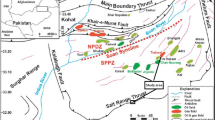Abstract
Lunnan heave had experienced denudation during late Caledonian and Hercynian movements and reconstruction during Indosinian movement. Lunnan heave and its circumference areas are located on the direction of petroleum migration, and experienced three reservoir formation cycles that are divided by wave cycle: The first reservoir formation cycle is characterized by breakage, the second by alteration, and the third by enrichment. Three layers of dissolving-cave developed on the vertical in Lunnan area. Development degree of slit-cave system and their connectivity are important factors to control petroleum enrichment in the weathering crust reservoir. The area where dissolving-caves are communicated by silts and faults was a fine petroleum enrichment area, and water was often encountered in the area with isolation cave while drilling because of no oil and gas origin. The top part of the faulted-horst as a leaking area is bearing water area, and the higher part of slope nearing the top part of the faulted-horst as a high seepage area is a heavy oil area due to lack of fine cap rock, and the lower part of slope and the platform are light and condensate oil area. The area with the middle-upper Ordovician is the favorable area to explore original carbonate reservoir formed in the earlier stage. The best favorable petroleum enrichment area for carbonates is surrounding Lunnan heave along the slope down to the direction of sags. The precondition to discover petroleum in carbonates is accurately prognosticating the distribution area of silts and caves, and the key to improving the exploration success ratio is accurately recognizing silts and small faults.
Similar content being viewed by others
References
Lü Xiuxiang, Jin Zhijun, Pi Xuejun et al., Hydrocarbon accumulation and distribution in lower Paleozoic carbonates in Tarim Basin, Science in China, Series D, 2000, 43(5): 501–506.
Gu Qiaoyuan, Pan Wenqing, Cao Shuling, The Ordovician reservoir characteristics in Lunnan area, Xinjiang Petroleum Geology (in Chinese), 1999, 20(3): 210–212.
Zhou Dongyan, Zhou Xingxi, Gu Jiayu, Reservoir forming mechanism of karst system in Ordovician weathering crust in Lunnan area, Xinjiang Petroleum Geology (in Chinese), 1999, 20(3): 199–202.
Zhou Xingxi, Discussion on network-like oil and gas pools in carbonate—an example from Ordovician burial hill reservoir in Lunnan area, Tarim Basin, Petroleum Exploration and Development (in Chinese), 2000, 27(3): 5–8.
Gu Jiayu, Zhou Xingxi, Liu Wenlin et al., Distribution Law of Karst and Oil-Gas in Lunnan Burial Hill of Tarim Basin (in Chinese), Beijing: Petroleum Industry Press, 2001, 200–202.
Zhang Kang, Wang Darui, Types of karst-fractured and porous reservoirs in Chinese Carbonates and the Nature of the Tahe Oilfield in the Tarim Basin, Acta Geologica Sinica, 2004, 78(3): 866–872.
Zhao Mengjun, Huang Dipan, Correlation of the oils and source in Ordovician Tarim Basin, in Advances in Petroleum Geology in Tarim Basin (eds. Tong Xiaoguang, Liang Digang, Jia Chengzao) (in Chinese), Beijing: Science Press, 1996, 300–310.
Liang Digang, Gu Qiaoyuan, Pi Xuejun, Distribution law of the condensate gas reservoirs in Tabei uplift, Natural Gas Industry (in Chinese), 1998, 18(3): 5–9.
Gu Qiaoyuan, Han Jianfa, Zhang Yaotang, Fractal characteristics of fault and fracture in Ordovician reservoir in Lunnan area, Xinjiang Petroleum Geology (in Chinese), 1998, 19(4): 287–289.
Xu Jie, Li Tao, Chen Guoguang et al., Structural features of the buried hill in Lunnan area of Tarim Basin, Acta Petrolei Sinica (in Chinese), 2002, 23(5): 14–18.
Lü Xiuxiang, Jin Zhijun, Ma Yujie et al., Geological process reconstructing the Ordovician carbonate reservoir in Tarim Basin, in Formation Mechanism and Exploration Practice on the Subtle Reservoir (eds. Li Pilong, Pang Xiongqi) (in Chinese), Beijing: Petroleum Industry Press, 2004, 312–316.
Jin Zhijun, Lü Xiuxiang, Wang Yi et al., Sedimentary wave processes and its effect on controlling petroleum (in Chinese), Beijing: Petroleum Industry Press, 2003, 65–67.
Wang Jianbao, Guo Rutai, Xiao Xianming et al., Timing and phases of hydrocarbon migration and accumulation of the formation of oil and gas pools in Lunnan low uplift of Tarim Basin, Acta Sedimentologica Sinica (in Chinese), 2002, 20(2): 320–325.
Lü Xiuxiang, Jin Zhijun, Distribution law of the carbonate oil-gas reservoir, Acta Petrolei Sinica (in Chinese), 2000, 21(3): 8–12.
Gu Jiayu, Characteristics and evolutional model of karst reservoir of lower Ordovician carbonate rocks in Lunnan area of Tarim Bain, Journal of Palaeogeography (in Chinese), 1999, 1(1): 54–60.
Chen Yicai, Shen Zhongmin, Li Yanjun et al., Formation mechanism and formation conditions of condensate pools in Lunnan low-uplift of Tarim Basin, Journal of Chengdu University of Technology (in Chinese), 2002, 29(5): 481–486.
Author information
Authors and Affiliations
Corresponding author
About this article
Cite this article
Lü, X., Jin, Z., Zhou, X. et al. Petroleum enrichment characteristics in Ordovician carbonates in Lunnan area of Tarim Basin. Chin. Sci. Bull. 49 (Suppl 1), 60–65 (2004). https://doi.org/10.1007/BF02890454
Received:
Accepted:
Issue Date:
DOI: https://doi.org/10.1007/BF02890454




